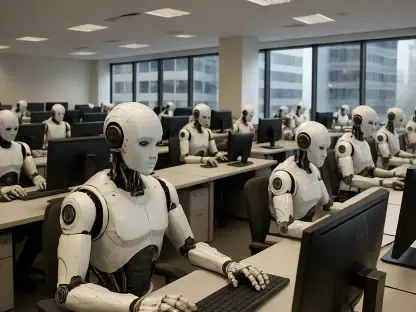In today’s rapidly evolving business landscape, companies are under pressure to adapt and leverage new technologies to remain competitive. Sofia Khaira, an expert in diversity, equity, and inclusion, joins us to share her insights on how AI-driven HR solutions, specifically Beamery’s new Workforce Intelligence Suite, can revolutionize workplace practices and enhance talent management.
What is Beamery’s Workforce Intelligence Suite, and how does it aim to transform the workforce?
Beamery’s Workforce Intelligence Suite is designed to transform how organizations approach workforce planning and development by providing deep insights into the specific tasks that make up various roles. This suite breaks down roles into manageable tasks to help leaders make smarter decisions related to talent management and automation. By understanding the intricacies of how work is actually performed, companies can align their strategies more effectively with their business goals.
Can you explain the concept of Task Intelligence and how it breaks down roles into tasks?
Task Intelligence is a powerful capability within the Workforce Intelligence Suite that dissects roles into individual tasks. This involves analyzing job descriptions, internal systems, and planning inputs to pinpoint the core tasks and necessary skills for each role. The breakdown helps in identifying which tasks are better suited for automation or need a human touch, ultimately improving efficiency and productivity.
How does Task Intelligence help identify opportunities for AI automation and role redesign?
By breaking down roles into their constituent tasks, Task Intelligence evaluates each task’s effort, skills requirements, and potential for automation. It flags high-effort, repetitive tasks that could be automated, freeing up employees’ time for more complex and strategic undertakings. This insight allows companies to redesign roles in a way that enhances productivity and job satisfaction.
Who is Ray, and how does this agentic AI consultant integrate into Beamery’s platform?
Ray is Beamery’s embedded agentic AI consultant designed to facilitate workforce transformation. Unlike traditional chatbots, Ray offers personalized recommendations and insights by leveraging data from Task Intelligence and other analytics. It helps leaders navigate talent decisions efficiently, with the precision and clarity required for such high-stakes determinations.
What challenges does Task Intelligence address for HR and C-suite leaders in workforce planning?
One of the main challenges Task Intelligence addresses is the lack of visibility into the specific tasks that each role entails. This visibility is crucial for making informed decisions about reskilling, redeploying talent, and applying AI. By providing this granular insight, Task Intelligence enables HR and executives to design more effective operating models and workforce strategies.
How does the Workforce Intelligence Suite build on Beamery’s existing talent acquisition capabilities?
The suite expands on Beamery’s previous focus on talent acquisition by integrating task-level analytics into workforce planning. It provides an extra layer of intelligence that allows businesses to not only bring in the right talent but also make informed decisions about reskilling, automation, and overall organizational design to ensure that human and technological resources are used optimally.
According to Sultan Saidov, why is it crucial for C-suite leaders to have an understanding of how work gets done?
Sultan Saidov emphasizes that without a granular understanding of how work occurs, C-suite leaders risk making uninformed decisions in an economy increasingly driven by AI. Understanding tasks at a detailed level helps them apply AI where it can be most beneficial and make strategic decisions about role redesign, automation, and reskilling with confidence.
What makes Task Intelligence a first-to-market feature, and what are its unique capabilities?
Task Intelligence is unique because it goes beyond traditional role and skill descriptions to provide insight into the actual tasks performed within roles. This enables companies to identify tasks amenable to automation, assess the required effort and skills, and redesign roles for greater efficiency, making it a pioneering approach in workforce analytics.
How does Task Intelligence help companies align people strategy with business goals?
By providing detailed insights into task-level work, Task Intelligence helps organizations align their people strategy with business objectives. It ensures that tasks contributing to the company’s goals are prioritized and those suitable for automation are identified. This alignment supports more agile and responsive workforce planning.
Why is visibility into specific tasks necessary, and how can it influence the application of AI?
Visibility into specific tasks allows businesses to accurately identify which aspects of work can benefit from automation, leading to more strategic application of AI. It helps avoid blanket approaches to automation by ensuring that only suitable tasks are automated, which maximizes productivity while maintaining job satisfaction.
How does Task Intelligence provide unprecedented insight into how work happens in organizations?
Task Intelligence offers unprecedented visibility by mapping out the specific tasks that comprise job roles. It combines internal data with external labor market signals to give a comprehensive view of how work is performed and where improvements can be made, providing a foundation for more strategic decisions.
How does the suite facilitate cost reduction and effective deployment of automation?
By identifying tasks that are strong candidates for automation, Task Intelligence enables organizations to allocate resources more effectively, leading to cost reduction. Automating high-effort, repetitive tasks can save time and money, allowing human employees to focus on higher-value tasks that drive business success.
What role does enriched task-level intelligence play in evaluating tasks?
Enriched task-level intelligence offers a detailed evaluation of each task based on its demand, effort, skill requirements, and automation potential. This robust analysis helps leaders decide which tasks should be automated, reskilled, or retained as they are, ensuring resources align with strategic goals.
How does Task Intelligence identify tasks that are suitable candidates for automation?
It uses advanced analytics to spot high-frequency, time-consuming tasks that can be automated without sacrificing quality or creativity. Task Intelligence thoroughly evaluates tasks for their potential to be automated, based on their complexity and the frequency with which they occur.
Can you elaborate on how the suite assists with reskilling and redeployment pathways?
By pinpointing business-critical tasks and matching them with available skill sets within the organization, the suite helps in crafting reskilling and redeployment strategies. It ensures that employees can transition into roles where they are most needed, thereby supporting workforce agility and career development.
What is meant by a “digital organizational twin,” and how does it aid in scenario modeling?
A digital organizational twin is a virtual representation of a company’s workforce. It simulates the impact of potential changes, such as automation or workforce adjustments. This modeling enables leaders to foresee the outcomes of various scenarios and make data-driven decisions to optimize workforce structure.
How does the example of a global insurance provider illustrate Task Intelligence in action?
In the insurance provider’s case, Task Intelligence was used to model tasks across their combined workforce during a merger. This helped them understand the task distribution and identify overlapping roles or tasks that could be automated, optimizing their workforce efficiency and synergy post-merger.
What insights were gained by the manufacturing company regarding senior engineers, and how did it affect their task distribution?
The manufacturing company discovered that senior engineers were involved in basic troubleshooting tasks that could be delegated to less experienced staff. By redistributing these tasks, the company allowed engineers to focus on more complex problems, enhancing their satisfaction and productivity.
How did Task Intelligence help a financial services firm optimize its workforce without hiring externally?
The financial services firm used Task Intelligence to reassign customer-facing employees known for their deep product knowledge into quality assurance roles, while also automating repetitive support tasks. This reallocation helped them optimize workforce capabilities without the need for external hiring.
How did a technology company use Task Intelligence to improve collaboration between Product Managers and UX Designers?
The technology company found that its Product Managers and UX Designers were duplicating user research efforts. By streamlining these tasks, they reduced inefficiencies and enhanced collaboration, ultimately leading to more cohesive and innovative product development.
What differentiates Ray from traditional chatbots or copilots?
Ray stands out because it is not just another chatbot; it’s a holistic AI consultant designed to guide workforce transformation. Ray processes real-time data to provide strategic insights and recommendations, tailored to specific organizational needs and goals, rather than responding to generic inquiries.
How does Ray use real-time insights from Task Intelligence to provide contextual recommendations?
Ray taps into real-time Task Intelligence data to deliver contextual recommendations that align with user goals. Whether it’s workforce planning, hiring, or upskilling, Ray’s suggestions are grounded in up-to-date intelligence, helping leaders make informed decisions swiftly.
In what ways does AI change the process of making workforce decisions according to Sharath Hari?
Sharath Hari highlights that AI shifts workforce decision-making from being purely intuitive to data-driven. With AI, decisions encompass wider insights and clearer visualization of data, allowing executives to make informed decisions more intuitively without being bogged down by manual data analysis.
How can senior enterprise executives engage with workforce data more intuitively through AI agents?
AI agents like Ray offer senior executives an intuitive interface to engage with complex workforce data. By simplifying analytics into actionable insights, these agents empower leaders to interact with data more dynamically, making it easier to visualize and apply information for strategic transformation.
How does Ray contribute to making complex transformation decisions easier for leaders?
Ray facilitates easier decision-making by offering clear, data-backed insights directly related to organizational goals. Its ability to synthesize complex information into understandable recommendations allows leaders to tackle transformation projects with enhanced confidence and decisiveness.
What is your forecast for how AI and Task Intelligence will shape the future of workforce management?
I anticipate that AI and Task Intelligence will become integral to workforce management, making companies more agile and efficient. They will facilitate a fine balance between automation and human capabilities, emphasizing skill development alongside technology implementation. This will lead to more personalized career pathways, better employee satisfaction, and overall organizational success.









